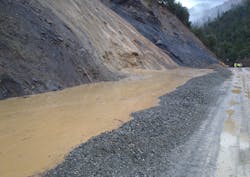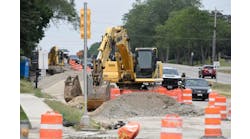When visitors drive by the portion of S.R. 299 in California known as Big French Creek, they may notice the rock-fall protection fence or perhaps other improvements; but they most likely have no idea what local residents, the traveling public and the California Department of Transportation (Caltrans) District 2 went through for almost two years to bring this highway back to normal.
Along with moving 900,000 cu yd of dirt, the Big French Creek Emergency Project in Trinity County delivered a large, state-of-the-art catchment area, new guardrail, a new drainage system, a rock-fall protection fence and wall, and repaved roadways including disposal sites. Caltrans and its contractors met the enormous project and its challenges with skill, talent and capability.
It all started when rocks fell
On January 16, 2016, a major rock-fall incident represented an immediate threat to the traveling public, to which Caltrans promptly responded. A few days later on January 27, as soon as a Director’s Order was approved, a contract was awarded to Stimpel-Wiebelhaus Associates Inc., and construction work began. Nobody imagined this would be the beginning of a two-year odyssey, one that would test the public’s patience and the contractor’s expertise; but also one that would prove once again that Caltrans is ready for an emergency project of this magnitude, and more than willing to work with all agencies and communities involved to fulfill their transportation needs while fixing and rebuilding the highway.
The initial goal was to bring the road back to normal by removing debris (rock and soil), cleaning the roadway and providing a 24-hour traffic-control system with spotters in place.
“This was to protect the traveling public as falling rocks seemed to randomly reveal themselves from more than 500 ft above the roadway and project themselves into the travelled way and beyond with little notice and with tremendous force,” Caltrans engineer Brent Clements said.
Quickly, the need for a temporary rock-fall protection fence (RFPF) was identified and installed on top of K-rail barriers along the centerline of the roadway shortly thereafter. The Caltrans geotechnical design team recommended the installation of an approximate 92,000 sq ft of Cable Net Drapery System (CNDS) on the slope. Originally it was anticipated that this would be a six-month contract during the winter season and once the weather subsided, an end to the story.
A mudslide
When March 2016 arrived, a mudslide carrying approximately 2,500 cu yd destroyed the fence. Traffic control and its subsequent delays were not just an effect but a necessity. Caltrans could not let the traveling public go through a road that was flooded.
The Construction team, led by Clements and resident engineer Tofael Anwar, called upon Caltrans Geotechnical Services to begin studying new approaches. The area was surveyed via aerial data acquisition; horizontal drilling and seismic refraction was done for subsurface investigation. After several months of studies, it was decided to create a catchment area that would hold 3,000 to 4,000 cu yd of slide material; a new scope of work was developed and the respective Director’s Order was issued.
“The site was so dynamic, and conditions changed daily; rain and other winter conditions came through after a few years of drought,” Anwar said. “After studying the jobsite, based on field survey and other available information, it was determined the need for a new scope of work.”
Taking a different direction
In July 2016, a new contract was awarded to Steve Manning Inc., and they worked for a number of months. Parallel to them, Caltrans District 2 construction, project management, right of way and environmental teams worked with other agencies to comply with environmental laws, as the new scope of work would have impacts to the traveling public, the environment and other stakeholders. It was also necessary to find disposal sites and work with local businesses and residents.
“Big French Creek was certainly challenging, but we diligently faced every challenge at hand,” Clements said. “We followed through, carefully revising and redirecting our efforts as we deemed appropriate.”
Full closure
Towards the end of 2016 another slide occurred. This particular slide quickly became a serious threat to safety and forced Caltrans to close the highway and develop a new plan of action. Caltrans’ contractor Steve Manning was working at full force, and had people working day and night to achieve this while other teams focused on other pressing aspects such as finding viable disposable sites for large amounts of dirt and debris.
January 2017 arrived, and most of the traveling public did not understand what was going on. What they saw was that the road was closed and that it was hindering their normal life.
“People needed to go to doctor’s appointments and couldn’t. Students missed school and parents and educators were not happy about it. It was costly to companies who couldn’t do business as usual thus losing goods and money,” recalls Denise Yergenson, Caltrans public information chief. “The public was angry for having to deal with this chaos, and rightfully so, demanded actions right away.”
Work in action
Work took place rain or shine and regardless of interruptions by slides small and large, under extreme winter weather for months, and all of this while managing traffic and the demands of not just one but several stakeholder groups. Local schools, county transportation agencies, companies whose business is the transportation of goods, elected officials advocating for their constituency, and extremely vocal residents, each one demanded their particular needs to be met, but most of all, they just wanted to have the road open as often as possible.
The peak of every project
Not everything was ideal and not everybody was in agreement with the approach or the short-term results, but the project kept moving in the direction set by those leading it and they proved that the big picture they envisioned was right.
Similarly, the public’s impatience grew. Local residents and frequent travelers made public comments, questioning the decisions made by Caltrans and exasperated with the traffic delays. The most common comment expressed in public, on the Caltrans social media outlets, was suggesting that the agency should have built a bridge over the Trinity River. However, the Public Information Office explained that environmental laws protect the area and prevent such approaches.
“Our focus was to deliver a safe road and to open to traffic as early as possible, and we did it,” Anwar said. “I think our success is that we were able to continue moving forward long term in the midst of all these difficult circumstances.”
Extreme weather conditions
The extremely wet winter caused enormous flooding, slides and slip-outs. The Big French Creek Emergency Project kept going and with it, a series of traffic-control operations.
“It was extremely necessary to establish continuous coordination efforts with local communities so that they knew what to expect,” Caltrans District 2 Director Dave Moore said. “We met with local residents and elected officials, and established communication mediums to assist local communities while the project was going on.”
After having the highway shut down for 37 calendar days, a detour was open two times per day, limited to school buses, teacher and emergency vehicles. People felt a little more hopeful, but there still was a lot to do. And the threat of another slide was as real as the heavy winter.
“Many of us in District 2 realized how important it was to keep the public well informed, and after that realization we communicated more often than we would do with our usual outreach, giving them more details as to how the project was coming along,” Project Manager Matt Gowan said.
Public outreach
The Caltrans District 2 Public Information Office (PIO) coordinated a few press conferences and media interviews as the project developed. PIO also created and implemented a communication plan mostly focusing on social media and digital communication weekdays and weekends, providing updates several times during the day and night, quickly providing the latest information often up to the minute. A hotline was updated daily, group emails were sent to those who provided their email address. Flyers were placed at certain public places, and the office responded to daily calls and one-on-one requests with the firm objective to keep the public informed, and thus minimizing the possibility of rumor and misinformation. A telephone landline was installed in this remote area for 24/7 communication between the teams. This was particularly helpful for solving critical issues without delay.
The Big French Creek construction team, the project manager and executive staff were on top of monitoring the ins and outs of this project, and met countless times to coordinate efforts. Facebook and Twitter proved to be a viable medium for informing local residents, especially in areas where cell coverage or internet access was challenging, as was the case for Burnt Ranch, Del Loma, Big Bar and other localities.
When the spring of 2017 arrived, District 2 had established strong ties with motorists and local agencies, who often used that stretch of S.R. 299 as well as with frequent traveling businesses and visitors. Large trucks, public transportation buses, school buses, RVs, and the vehicles of local residents and visitors often use S.R. 299 as it links Redding to the coast. Elected officials were also advised of the project as it developed; some of them visited the site to understand both magnitude and need.
Project completed
Two years after construction, at a cost of $40 million, the Big French Creek Emergency Project features a rock-fall protection fence and wall, new guardrail, a state of the art catchment area, new drainage systems and a repaved roadway. The traveling public can now drive through a much safer section of road.
Caltrans District 2 takes pride in the dedication its employees exhibit when called for a task. It is precisely the ability to continue moving forward despite circumstances and setbacks that defines the success of a project, and the Big French Creek team and partners did just that.



